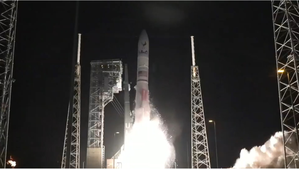US’ 1st fully private spacecraft starts journey to Moon
US-based Astrobotic Technology’s Peregrine lunar lander has successfully started the historic mission to the Moon on Monday, aiming to bring America back to the lunar terrain after about 50 years.
The US has not attempted a moon landing since Apollo 17 in December 1972.
The lander lifted off aboard United Launch Alliance’s brand new rocket Vulcan Centaur at 2:18 a.m. EST (7:18 GMT), from Cape Canaveral Space Force Station in Florida.
After dwelling in a stable orbit and performing system checkouts, it aims to attempt the historic landing on February 23.
“Astrobotic’s historic Peregrine lunar lander has successfully launched and acquired ground communications with our DHL Mission Control Center!” the company wrote on its website.
“The first US commercial robotic launch to the Moon successfully lifted off Jan 8 on the first flight of ULALaunch’s VulcanRocket. Astrobotic’s Peregrine Mission 1 lander is expected to reach the lunar surface in February,” NASA wrote on X.
Peregrine is Astrobotic’s first lander mission, and the team plans to become the first commercial company to successfully land a spacecraft on the lunar surface.
The lander carries a total of 20 payloads, or cargo, including 5 from NASA’s Commercial Lunar Payload Services (CLPS) initiative.
The payload teams have missions that vary from seeking indications of water-ice near the lunar surface to demonstrating a rover swarm. The lander also has several payloads representing humanity through artwork and historical artefacts.
“The first CLPS launch has sent payloads on their way to the Moon — a giant leap for humanity as we prepare to return to the lunar surface for the first time in over half a century,” said NASA Administrator Bill Nelson, in a statement.
“These high-risk missions will not only conduct new science at the Moon, but they are supporting a growing commercial space economy while showing the strength of American technology and innovation. We have so much science to learn through CLPS missions that will help us better understand the evolution of our solar system and shape the future of human exploration for the Artemis Generation,” he added.
After landing on the Moon in February, Peregrine will spend approximately 10 days gathering valuable scientific data studying Earth’s nearest neighbour and helping pave the way for the first woman and first person of colour to explore the Moon under Artemis.
On the Moon, NASA instruments aboard the lander will study the lunar exosphere, thermal properties of the lunar regolith, hydrogen abundances in the soil at the landing site, and conduct radiation environment monitoring.
The five NASA science and research payloads aboard the lander will help the agency better understand planetary processes and evolution, search for evidence of water and other resources, and support long-term, sustainable human exploration.

